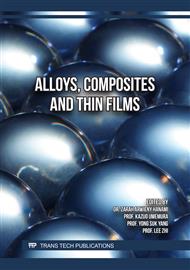[1]
N. Saba, M. T. Paridah, and M. Jawaid, "Mechanical properties of kenaf fibre reinforced polymer composite: A review," Feb. 01, 2015, Elsevier Ltd.
DOI: 10.1016/j.conbuildmat.2014.11.043
Google Scholar
[2]
S. D. Salman, "Partial replacement of synthetic fibres by natural fibres in hybrid composites and its effect on monotonic properties," Journal of Industrial Textiles, vol. 51, no. 2, p.258–276, Aug. 2021.
DOI: 10.1177/1528083719878843
Google Scholar
[3]
P. Wambua, J. Ivens, and I. Verpoest, "Natural fibres: Can they replace glass in fibre reinforced plastics?," Compos Sci Technol, vol. 63, no. 9, p.1259–1264, 2003.
DOI: 10.1016/S0266-3538(03)00096-4
Google Scholar
[4]
R. Sepe, F. Bollino, L. Boccarusso, and F. Caputo, "Influence of chemical treatments on mechanical properties of hemp fiber reinforced composites," Compos B Eng, vol. 133, p.210–217, Jan. 2018.
DOI: 10.1016/j.compositesb.2017.09.030
Google Scholar
[5]
M. R. Sanjay, G. R. Arpitha, L. L. Naik, K. Gopalakrishna, and B. Yogesha, "Applications of Natural Fibers and Its Composites: An Overview," Natural Resources, vol. 07, no. 03, p.108–114, 2016.
DOI: 10.4236/nr.2016.73011
Google Scholar
[6]
K. P. Ashik and R. S. Sharma, "A Review on Mechanical Properties of Natural Fiber Reinforced Hybrid Polymer Composites," Journal of Minerals and Materials Characterization and Engineering, vol. 03, no. 05, p.420–426, 2015.
DOI: 10.4236/jmmce.2015.35044
Google Scholar
[7]
A. Karimah et al., "A comprehensive review on natural fibers: Technological and socio-economical aspects," Dec. 01, 2021, MDPI.
DOI: 10.3390/polym13244280
Google Scholar
[8]
Z. Djafar, I. Renreng, and M. Jannah, "Tensile and Bending Strength Analysis of Ramie Fiber and Woven Ramie Reinforced Epoxy Composite," Journal of Natural Fibers, vol. 18, no. 12, p.2315–2326, 2021.
DOI: 10.1080/15440478.2020.1726242
Google Scholar
[9]
S. C. Ramesh Kumar, R. V. P. Kaviti, L. Mahesh, and B. M. Mohan Babu, "Water absorption behavior of hybrid natural fiber reinforced composites," Mater Today Proc, vol. 54, p.187–190, Jan. 2022.
DOI: 10.1016/j.matpr.2021.08.281
Google Scholar
[10]
C. Z. Paiva Júnior, L. H. De Carvalho, V. M. Fonseca, S. N. Monteiro, and J. R. M. D'Almeida, "Analysis of the tensile strength of polyester/hybrid ramie-cotton fabric composites," Polym Test, vol. 23, no. 2, p.131–135, Apr. 2004.
DOI: 10.1016/S0142-9418(03)00071-0
Google Scholar
[11]
D. K. Debeli, Z. Qin, and J. Guo, "Study on the Pre-Treatment, Physical and Chemical Properties of Ramie Fibers Reinforced Poly (Lactic Acid) (PLA) Biocomposite," Journal of Natural Fibers, vol. 15, no. 4, p.596–610, Jul. 2018.
DOI: 10.1080/15440478.2017.1349711
Google Scholar
[12]
C. Wang, Z. Ren, S. Li, and X. Yi, "Effect of ramie fabric chemical treatments on the physical properties of thermoset polylactic acid (PLA) composites," Aerospace, vol. 5, no. 3, Sep. 2018.
DOI: 10.3390/aerospace5030093
Google Scholar
[13]
H. Wang, G. Xian, H. Li, and L. Sui, "Durability study of a ramie-fiber reinforced phenolic composite subjected to water immersion," Fibers and Polymers, vol. 15, no. 5, p.1029–1034, 2014.
DOI: 10.1007/s12221-014-1029-7
Google Scholar
[14]
Z. Djafar, Ilhamzah, and I. Renreng, "Effect of Seawater Immersion on Impact Strength of Composites Reinforced Ramie Fiber," Journal of the Japan Institute of Energy, p.99, 117–122, 2020.
DOI: 10.3775/jie.99.117
Google Scholar
[15]
A. Smoca, "Water absorption properties of hemp fibres reinforced PLA bio-composites," in Engineering for Rural Development, Latvia University of Life Sciences and Technologies, 2019, p.1079–1083.
DOI: 10.22616/ERDev2019.18.N522
Google Scholar



